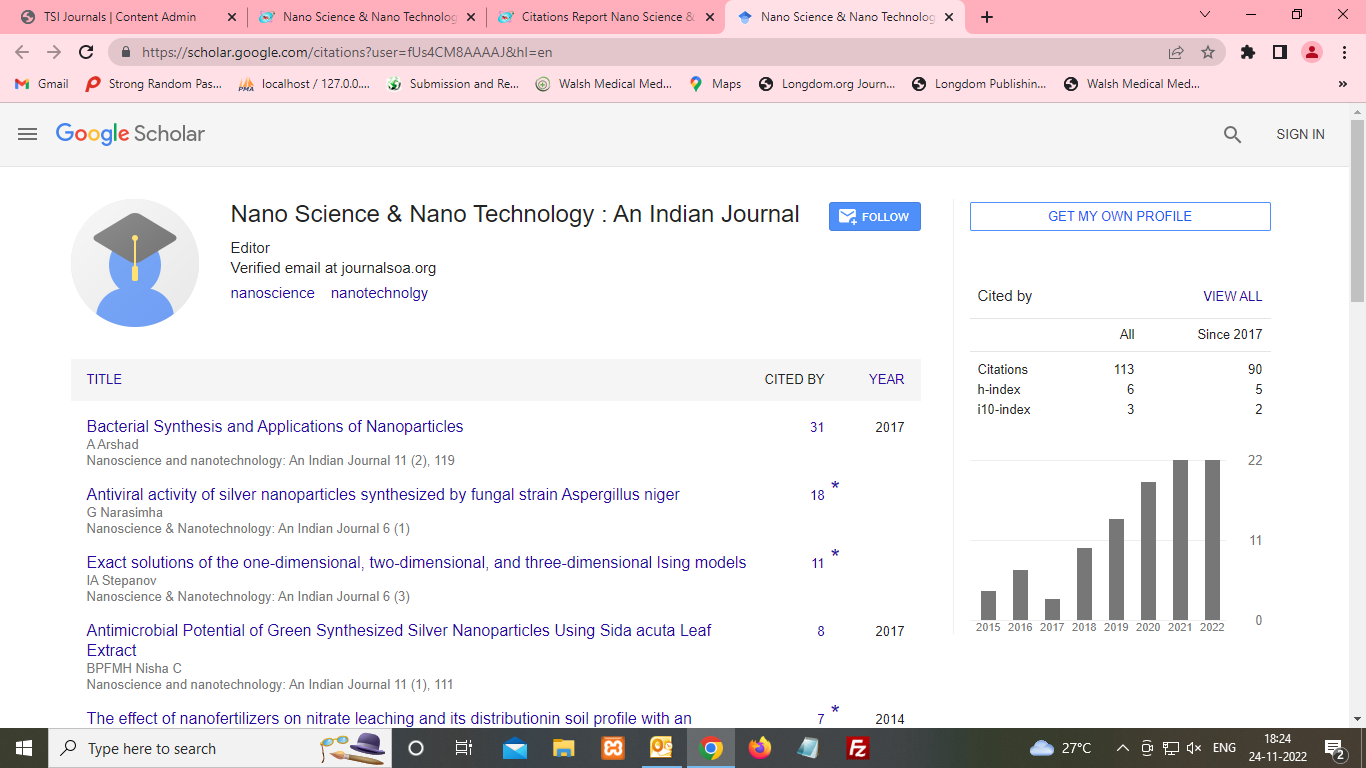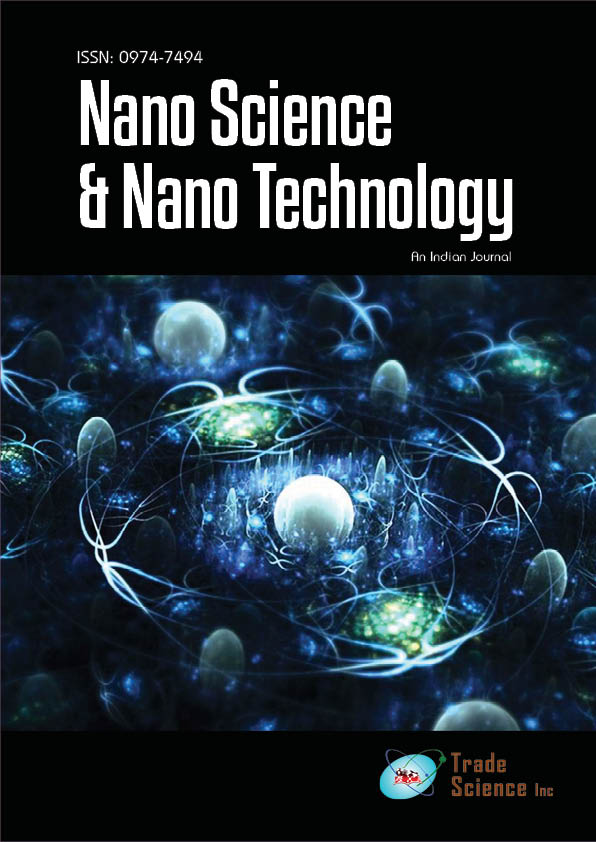Viewpoint
, Volume: 16( 3) DOI: 2022; 16(3):155In Microbiology and Infectious Disease Diagnostics: The Use of Scanning Electron Microscope
- *Correspondence:
- Ellen Barker Editorial office, Nanoscience & nanotechnology: An Indian Journal, UK. ; E-mail: info@tsijournals.com
Citation: Barker E. In Microbiology and Infectious Disease Diagnostics: The Use of Scanning Electron Microscope. Nano Tech Nano Sci Ind J. 2022; 16(3):155 .
Abstract
In early research, electron microscopy proved critical in identifying infectious illness causal agents. It is still an essential technique for diagnosing diseases and testing for microorganism identification. Negative staining for transmission electron microscopy (TEM) has traditionally been considered the "gold standard" for imaging microbiological samples, such as in diagnostic virology. Negative-stain TEM, on the other hand, need a sufficient concentration of bacterial cells or virus particles, as they are adsorbed to a thin support surface. Microbes must thus be grown to a high tire and/or concentrated by centrifugation, which is typically impossible with patient materials. As a result, for many sorts of microbiological studies, electron microscopy has historically had low test sensitivity. For TEM to identify agents such as poxviruses or polyomaviruses in patient specimens, a minimum concentration of 105 to 106 particles/ml is normally required. By contrast, the detection level of viruses utilizing culture or nucleic acid testing typically varies from 1 to 50 particles per assay. Because of recent advancements in filtering methods, TEM and SEM virus detection may now be performed with as few as 5000 total particles per sample. Furthermore, electron microscopy may be used to determine the kind of microbe present, typically down to the genus level, allowing additional specialized tests (such as primers or particular antibodies) to be used to properly identify the agents present.Perspective
In early research, electron microscopy proved critical in identifying infectious illness causal agents. It is still an essential technique for diagnosing diseases and testing for microorganism identification. Negative staining for Transmission Electron Microscopy (TEM) has traditionally been considered the "gold standard" for imaging microbiological samples, such as in diagnostic virology. Negative-stain TEM, on the other hand, need a sufficient concentration of bacterial cells or virus particles, as they are adsorbed to a thin support surface. Microbes must thus be grown to a high tire and/or concentrated by centrifugation, which is typically impossible with patient materials. As a result, for many sorts of microbiological studies, electron microscopy has historically had low test sensitivity. For TEM to identify agents such as poxviruses or polyomaviruses in patient specimens, a minimum concentration of 105 to 106 particles/ml is normally required. By contrast, the detection level of viruses utilizing culture or nucleic acid testing typically varies from 1 to 50 particles per assay. Because of recent advancements in filtering methods, TEM and SEM virus detection may now be performed with as few as 5000 total particles per sample. Furthermore, electron microscopy may be used to determine the kind of microbe present, typically down to the genus level, allowing additional specialized tests (such as primers or particular antibodies) to be used to properly identify the agents present.
Despite being an excellent tool for investigating ultrastructure, Scanning Electron Microscopy (SEM) is less frequently used than transmission electron microscopy for microbes such as viruses or bacteria. Here we describe rapid methods that allow SEM imaging of fully hydrated, unfixed microbes without using conventional sample preparation methods. We demonstrate improved ultrastructural preservation, with greatly reduced dehydration and shrinkage, for specimens including bacteria and viruses such as the Ebola virus using infiltration with ionic liquid on conducting filter substrates for SEM.
Growth of bacteria
Salmonella Senftenberg strains were cultured overnight in 3 mL LB broth at 37°C with shaking (kindly donated by Dr. George Golding, National Microbiology Laboratory). 50 l of bacteria were then subcultured into three ml of LB broth and cultivated for four h at 37°Cwith shaking to the approximate mid-log phase of development. The bacteria were fixed for 1 h at room temperature in a 1:1 v/v solution of 1% paraformaldehyde and 2% glutaraldehyde. Dr. Robbin Lindsay of the National Microbiology Laboratory graciously contributed Leptospira biflexa serovar Patoc, which was cultured in Ellinghausen and McCullough medium modified by Johnson and Harris (EMJH) (Royal Tropical Institute, The Netherlands). The infected culture was kept at 30°C for 14 days before being stored in low light at room temperature.
SEM image analysis
All samples were scanned in a transportable biological containment cage using a JCM-5700 Scanning Electron Microscope (JEOL USA, Peabody, MA, USA) (Dycor Technologies Ltd, Edmonton, AB, Canada). Under high vacuum at 6 kV, gold coated specimens were photographed with an 8 mm working distance and a 30 m objective lens aperture. The secondary electron detector was used to take images; each image was 2560 pixels x 1920 pixels and took 160 sec to acquire. The above-mentioned parameters were used to create images of ionic liquid stained samples, with the exception that the acceleration voltage was increased to 4 kV. Images were captured using a scanning electron microscope at magnifications ranging from 3,000 times to 20,000 times.
Preparation and imaging of TEM samples
On a carbon-coated 400-mesh copper grid, samples were adsorbed for 1 min to a formvar film. The adsorbed samples were rinsed three times in distilled water and compared with 2% methylamine tungstate (Nano-W; Nanoprobes, Yaphank, NY, USA). An FEI Tecnai 20 transmission electron microscope was used to image the samples at 200 kV. (FEI Company, Hillsboro, OR, USA). An AMT Advantage XR 12 CCD camera was used to capture digital photographs of the specimens (AMT, Danvers, MA, USA). TEM pictures were taken at magnifications ranging from 3,500 times to 19,000 times.
Length measurements in image processing
The diameters of the Ebola virus, Salmonella Senftenberg, and Leptospira biflexa were measured using the straight-line tool and the analyze/measure function in the Image J software package34. The scale bars on the picture and the analyze/set scale function in Image J were used to calibrate length measurements. Because the bacteria and viruses have varied lengths but generally uniform diameters, only diameter measurements were taken for this study. MS Excel was used to compile and analyze the data. Biological specimens are frequently coated with thin-film evaporation or sputtering of carbon or metal in a vacuum coater to provide an electrically conductive surface for SEM, which necessitates preliminary dehydration of the specimen. Depending on the thickness of the layer deposited (typically 2 nm–20 nm), this coating procedure can hide tiny ultrastructural features. On normal microbiological specimens, which suspensions of min biological particles are generally in water (100 nm for most viruses, or submicrometer size range for many bacteria, fungi, and parasites), these standard methods are difficult to carry out. Another issue is that the microorganisms of interest in patient specimens or environmental samples may exist in low quantities, making their detection on a surface challenge.
Preparation of gold-coated samples for SEM imaging
Sample preparation was done in a Class II biosafety cabinet unless otherwise noted. SPI-pore polycarbonate track etch filters (SPI Supplies, West Chester, PA, USA) were used to pass all samples through a 13 mm Swinnex® filter unit (Millipore, Billerica, MA, USA). For bacterial sample preparation, 0.08 m pore size filters were employed, whereas MVA and Ebola virus preparations utilized 0.05 m pore size filters. Filters were first wetted in a 3 mL Luer-LokTM syringe with 2 mL Dulbecco's Phosphate-Buffered Saline (DPBS). In a 5 mL syringe, 100 mL of the sample was added to 5 ml DPBS to load the sample onto the filter.

